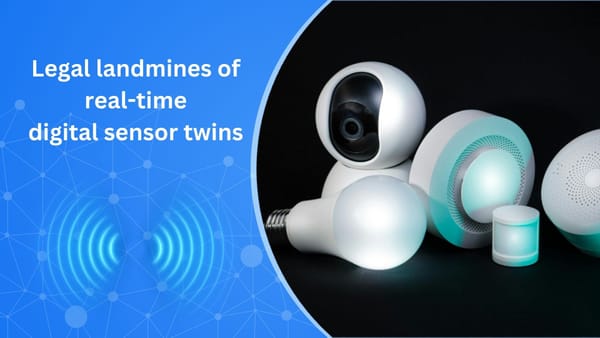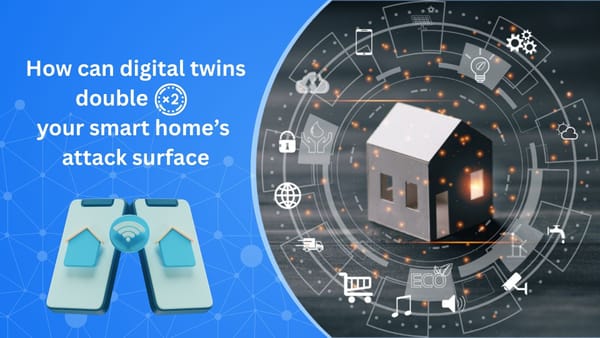Privacy vs. Convenience: How IoT Could Invade Your Personal Life
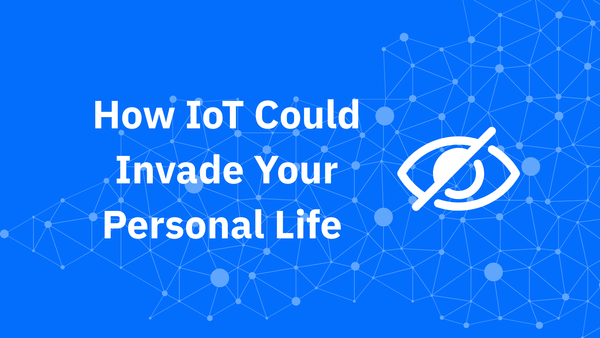
The rise of Internet of Things (IoT) technology has brought unprecedented convenience to our daily lives, often in exchange for personal data.
The hidden cost of smart living
The Internet of Things (IoT) promises to bring a new level of convenience by streamlining many aspects of your day. Smart thermostats “learn” their owners’ schedules, refrigerators suggest shopping lists, and home security systems monitor properties while owners are away.
At first glance, it looks like a utopia of convenience. However, there’s a catch: the promise of a seamless experience often comes at the cost of privacy.
As IoT ecosystems become increasingly integrated into everyday routines, the boundaries between personal space and aggressive data collection are blurring.
When smart becomes surveillance
Sensors, microphones and cameras are at the very core of IoT device functionality; after all, thermostats need to monitor temperature to make appropriate adjustments, and smart speakers need to hear your command to turn on the lights.
While the necessity of constant monitoring makes sense to ensure the device is always available for your convenience, it also acts as a constant window into your personal life.
Common data collection features in IoT devices
There’s no way around it: IoT devices collect data, some of them more than others. Some of the most common data collection habits and techniques include:
- Microphones that pick up ambient conversations, even when you’re not directly interacting with the host device
- Cameras used in doorbells, baby monitors, TVs, smart home monitoring systems, or even robot vacuums
- Location sensors embedded in mobile apps and wearable devices
- Environmental and behavioral data like sleep cycles, weight, body mass index (BMI), thermostat usage, screen time, and more
Most manufacturers process and store this data remotely, often relaying it through third-party cloud providers. While this is common among IoT device manufacturers, it exposes data to misuse, breaches, or even government data requests.
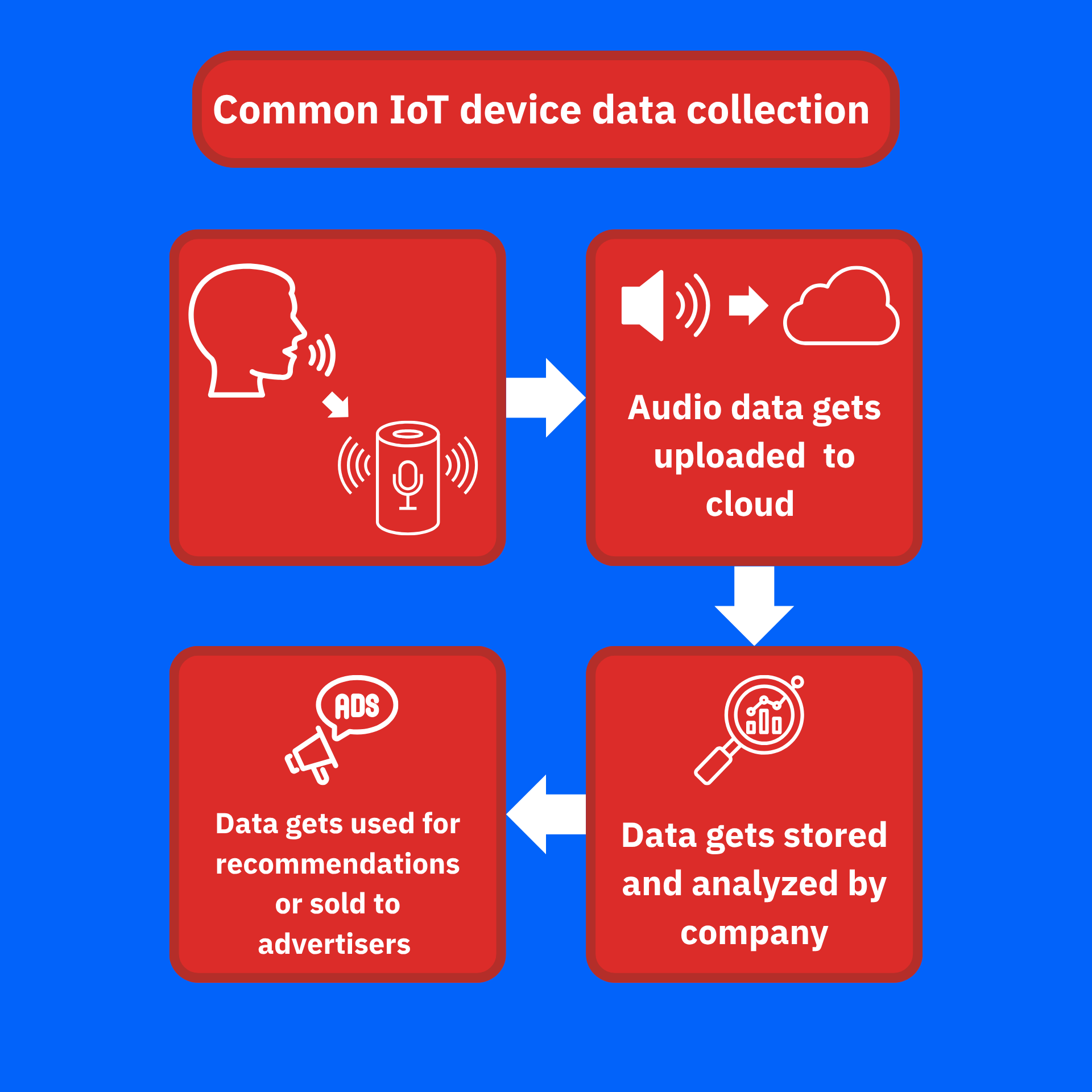
Legal and ethical implications
Data collection isn’t inherently evil. Many companies collect and process data solely to improve or tailor their services for their customers.
The real issues stem from the lack of transparency, consent and controls typically associated with data collection.
Modern privacy laws aim to mitigate these concerns by regulating abusive data collection practices. However, these laws can vary significantly by region and often struggle to keep pace with technological innovation.
Major privacy regulations
- GDPR (General Data Protection Regulation) applies to EU citizens and mandates data minimization, user consent and the “right to be forgotten”
- CCPA (California Consumer Privacy Act) gives California residents the right to know what data is collected and request its deletion
Although these regulations promote healthy data collection practices, they rely heavily on companies to self-report and users to take action. In other words, your privacy often depends on your vigilance and the honesty of companies.
Compounding the issue is the global nature of technology, as your data may be collected in your living room, sent to another country for storage, and processed somewhere else entirely, often with little clarity about where your rights begin and end.
Convenience is king, but it comes at a price
IoT technology and the ever-growing adoption of smart home ecosystems are driven by innovation, as well as demand. Users often overlook privacy in exchange for more convenience, whether it’s:
- Lights that adjust automatically when you walk in a room
- Smart watches that detect stress levels, step count and heart rate and offer healthy lifestyle suggestions
- Voice assistants that remember your favorite playlists, notify you about important events and help you place various orders online
Every layer of convenience adds a layer of risk. Whenever companies compete to make your life easier, the temptation to harvest more data for personalization or profit is strong.
An often-misconceived notion is that having nothing to hide means you have nothing to fear, but privacy is rarely about secrecy and more often about control. Who decides how much of your life is visible? And, more importantly, who benefits from that visibility?
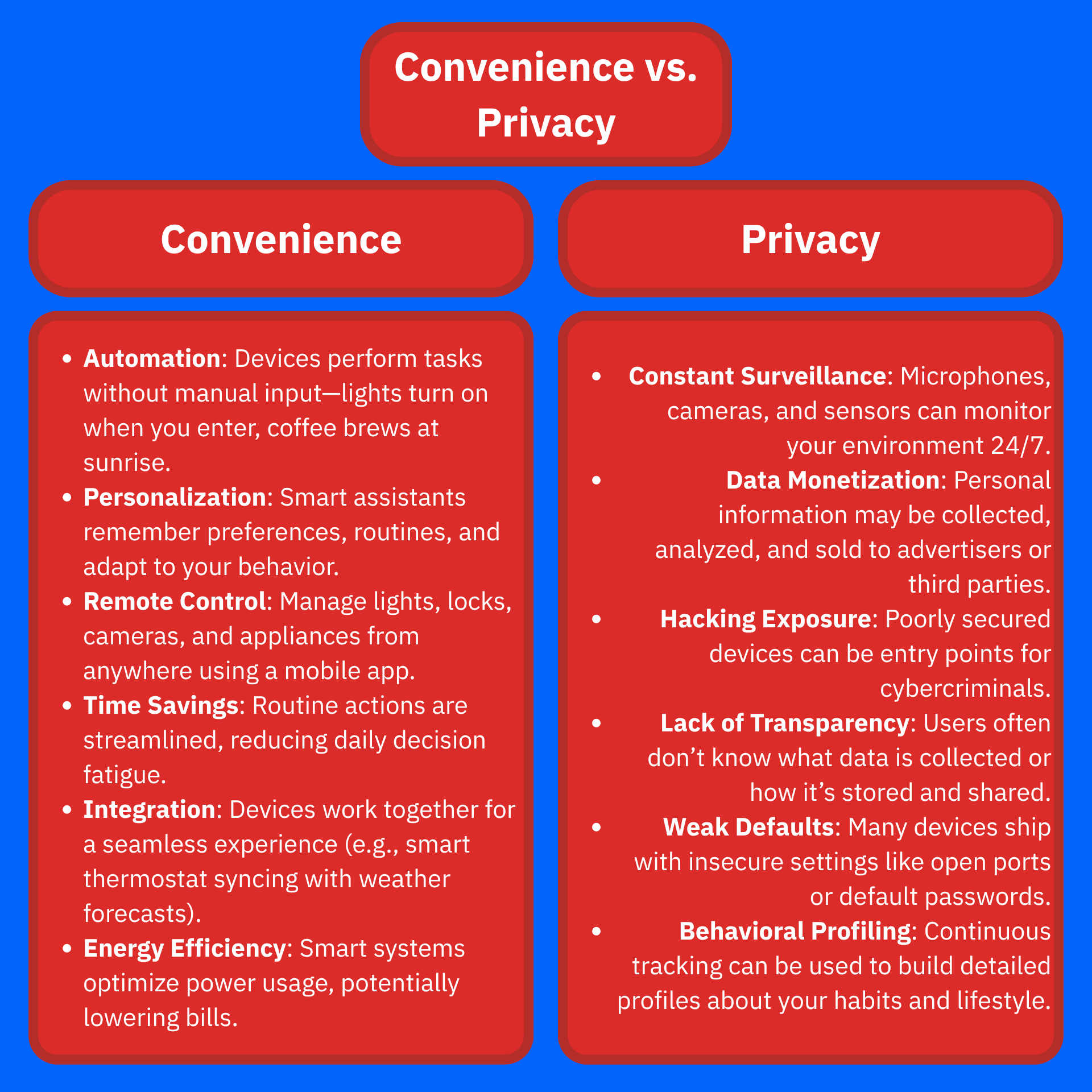
Best practices to regain privacy without giving up convenience
When it comes to convenience versus privacy, finding the right balance is key. You don’t have to live in a tech-free cabin in the woods to preserve your privacy, nor live in a glass house to enjoy the convenience brought by IoT ecosystems.
Taking a smart approach to preserve your privacy without giving up convenience can feel daunting, but it’s easier than it seems.
Tips to balance convenience with privacy
- Change default settings: Many devices collect way more data than they need by default. Disabling unnecessary data collection, such as voice history storage or background eavesdropping, can help you better preserve your privacy
- Check default permissions: Avoid giving apps or devices excessive permissions or access to your microphone, camera, or location, unless it’s absolutely necessary to their core functionality
- Use a guest network for IoT devices: Segregating IoT traffic from your main network can limit potential intrusions and lateral movement if one device is compromised
- Regularly update firmware: Frequently updating your device’s firmware or enabling auto updates can strengthen your digital resolve. Vulnerabilities in unpatched software or devices are an open door for attackers
- Read privacy policies: Manufacturers are legally obliged to be transparent about data collection. While most of them include information about their data collection practices in their Terms of Service or Privacy Policies, users typically skip reading them. Look for red flags like vague data-sharing clauses or third-party transfers
- Invest in privacy-focused brands: Some companies make a point of limiting data collection or encrypting collected data. Research before committing to a brand
- Use specialized software: Dedicated solutions like NETGEAR Armor provide a robust suite of tools to maintain your online safety and privacy
- Run monthly IoT security audits: Keeping a close eye on your smart home ecosystem can greatly help you catch vulnerabilities before they set off a dangerous domino effect
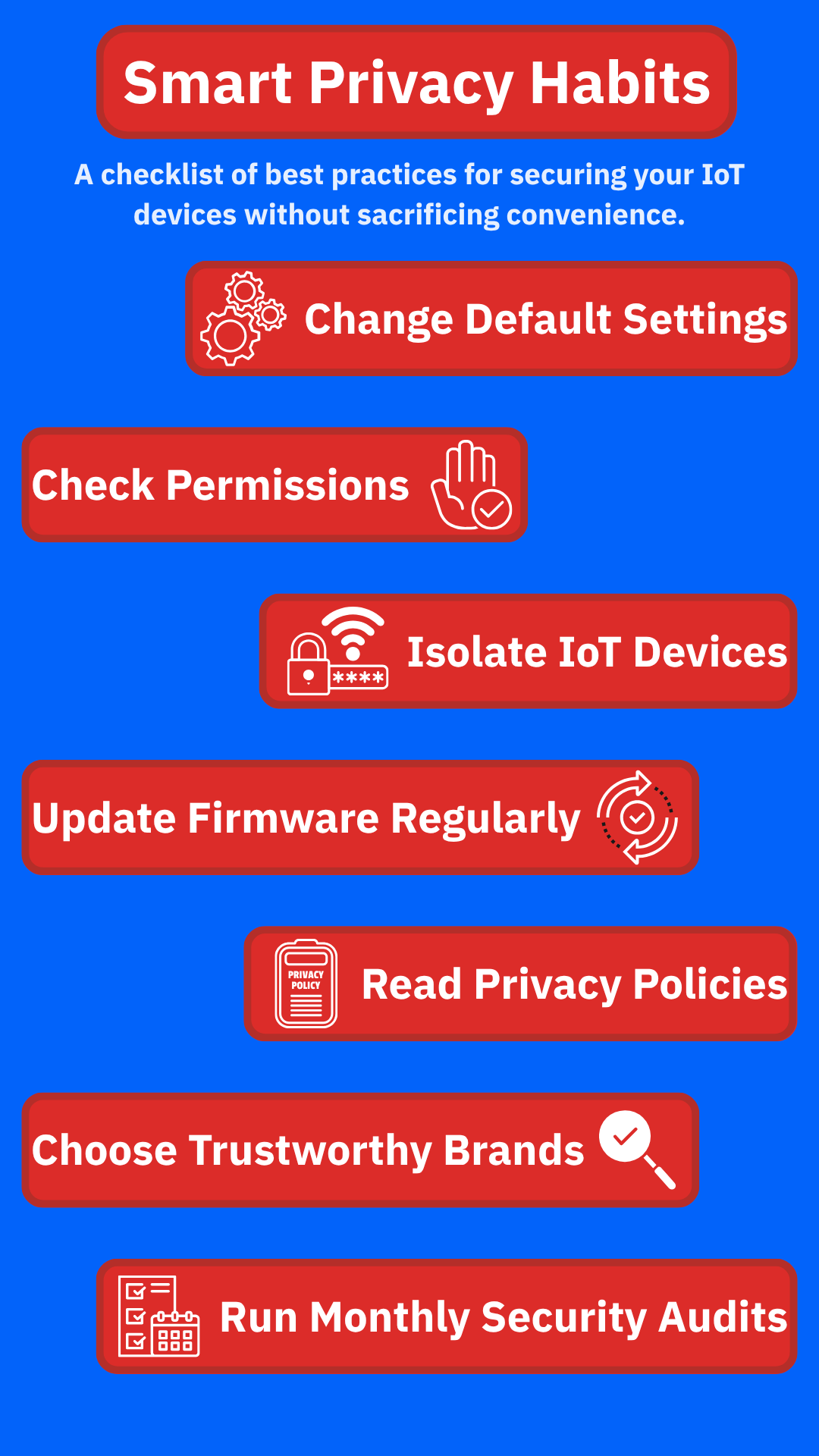
Evolving risks in a smarter world
As artificial intelligence (AI) continues its fusion with IoT, your devices will continue following commands, but they will also become increasingly able to predict behavior.
Although a powerful feature, predictive profiling can pave the way for more malignant privacy intrusions. Imagine your smart assistant being capable of adjusting your environment (lighting, temperature, ambient sounds) based on your mood, tone of voice, or even biometrics.
That future isn't far away, and if privacy isn’t prioritized now, it may become the price of entry.
Fortunately, the conversation is evolving. Regulators, journalists, and even manufacturers jumped on the bandwagon as they try to rethink default data practices. However, until systemic change arrives, the burden of protecting privacy largely remains a personal responsibility.
Choose convenience, but don’t sacrifice control
To wrap things up, IoT isn’t inherently invasive. However, its way of operating assumes that you don’t mind trading personal data for comfort. The more aware you are of that exchange, the more empowered you grow to decide when it’s worth it, and when the risks outweigh the benefits.
So go ahead, set up your smart lights, talk to your smart assistant, track your sleep, share your location data, but do it on your terms. Privacy and convenience don’t have to be mutually exclusive; with the right approach, they can easily coexist.
Frequently asked questions about IoT invading your personal life
What are the privacy issues with IoT?
The primary privacy concerns with IoT relate to abusive data collection. IoT manufacturers and third parties often collect and process data from device users. These points of data can then be used or disclosed for purposes outside of product or service functionality, including targeted advertising, social profiling, or even selling data to data brokers.
Is IoT a threat to privacy?
While IoT isn’t inherently a threat to privacy, it can be perceived as such. Many IoT devices collect extensive amounts of personal data, including biometrics, location, and behavioral patterns, often without user consent or transparent policies.
How does IoT affect human life?
IoT devices have brought unparalleled convenience to our daily lives, enabling us to remotely manage home environments, check security systems and adjust thermostats. However, they have also increased the attack surface for threat actors, which is why it’s crucial not to overlook security and privacy implications in the name of convenience.
tags
Author
Vlad's love for technology and writing created rich soil for his interest in cybersecurity to sprout into a full-on passion. Before becoming a Security Analyst, he covered tech and security topics.
View all postsRight now Top posts
How Do You Manage Your Passwords? We Ask Netizens
December 18, 2025
Cybercriminals Use Fake Leonardo DiCaprio Film Torrent to Spread Agent Tesla Malware
December 11, 2025
FOLLOW US ON SOCIAL MEDIA
You might also like
Bookmarks







